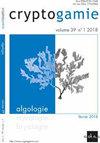石ophyllum artabricum V.Peña, sp. 11 (Corallinales, Rhodophyta):大西洋伊比利亚半岛的一个隐种,迄今归属于石ophyllum stictiforme (Areschoug) Hauck
IF 1.5
4区 生物学
Q3 MARINE & FRESHWATER BIOLOGY
引用次数: 3
摘要
刺形石ophyllum stictiforme (Areschoug) Hauck有助于地中海冠状结的形成。在大西洋伊比利亚半岛,根据潮下收集的资料也报道了L. stictiforme,显示了该物种的特征形态。最近的研究发现了一个来自地中海的多样的隐物种复合体,属于L. stictiforme。此后,对大西洋伊比利亚的收藏进行了重新评估,目的是澄清其分类地位。基于分子(COI, psbA)和形态学数据,对新种石叶草V.Peña, sp. 11进行了描述。分子系统发育分析一致地将大西洋伊比利亚收集作为一个独立的谱系从地中海L. stictiforme复合体。该新种的形态解剖学特征显示出与刺形支的地中海分支的形态解剖学特征重叠。然而,L. artabricum V.Peña, sp. 11 .具有巨大的体块结构,而地中海分类群主要是二聚体。此外,L. artabricum V.Peña, sp. 11 .与其他大西洋欧洲石粉科物种的不同之处在于,其外部形态由单个或重叠的片层组成,结构单一,孢子囊概念的管状孔呈圆锥形,并且仅发生在潮下基岩中。石ophyllum artabricum V.Peña, sp. 11 .目前已知分布于西班牙北部至葡萄牙北部。一组来自葡萄牙南部的L. stictiforme与L. artabricum V.Peña, sp. 11 .相似;然而,需要DNA序列数据来证实这一记录。根据本文提出的证据,L. stictiforme从西班牙北部和西北部以及葡萄牙北部的植物区系中被移除。该物种在暖温带水域的隐蔽性多样性的发现表明,应重新评估该物种在暖温带水域的进一步报道。本文章由计算机程序翻译,如有差异,请以英文原文为准。
Lithophyllum artabricum V.Peña, sp. nov. (Corallinales, Rhodophyta): A Cryptic Species in the Atlantic Iberian Peninsula Hitherto Assigned to Lithophyllum stictiforme (Areschoug) Hauck
ABSTRACT Lithophyllum stictiforme (Areschoug) Hauck contributes to the formation of the Mediterranean coralligenous concretions. In the Atlantic Iberian Peninsula, L. stictiforme has also been reported based on subtidal collections showing the characteristic morphology described for this species. Recent studies uncovered a diverse complex of cryptic species from the Mediterranean Sea assigned to L. stictiforme. Thereafter, the Atlantic Iberian collections have been re-assessed with the aim of clarifying its taxonomic status. Based on molecular (COI, psbA) and morphological data, the new species Lithophyllum artabricum V.Peña, sp. nov. is described herein. Molecular phylogenetic analyses were congruent in delimiting the Atlantic Iberian collections as an independent lineage from the Mediterranean L. stictiforme complex. Morpho-anatomical characters of the new species showed an overlap with those provided for the Mediterranean clades of L. stictiforme. However, L. artabricum V.Peña, sp. nov. has a monomerous thallus construction whereas the Mediterranean taxa were mainly dimerous. Moreover, L. artabricum V.Peña, sp. nov. differs from other Atlantic European Lithophyllum species by a combination of characters related to the external morphology consisting of single or superimposed lamellae, the monomerous construction, the conical shape of the canal pore of sporangial conceptacles, and by occurring only in subtidal bedrocks. Lithophyllum artabricum V.Peña, sp. nov. is at present known from northern Spain to northern Portugal. One collection of L. stictiforme from southern Portugal showed similarities with L. artabricum V.Peña, sp. nov.; however, DNA sequence data are necessary to confirm this record. Based on the evidence presented herein, L. stictiforme is removed from the flora of northern and northwestern Spain, and northern Portugal. The finding of cryptic diversity in L. stictiforme suggested that further reports of this species in warm and temperate waters should be re-assessed.
求助全文
通过发布文献求助,成功后即可免费获取论文全文。
去求助
来源期刊

Cryptogamie Algologie
生物-海洋与淡水生物学
CiteScore
2.60
自引率
7.70%
发文量
11
审稿时长
>12 weeks
期刊介绍:
Cryptogamie is a fast-track and peer-reviewed journal of international scope publishing in English only. It accepts original papers and review articles on the taxonomy, biology and ecology of all cryptogams. An issue of Cryptogamie may be devoted to a single topic, under the responsibility of guest editor(s). All articles published in Cryptogamie are compliant with the different nomenclatural codes. A copyright assignment will be signed by the authors before publication.
Cryptogamie, Algologie accepts articles on systematics as well as ecology and evolution of any kind of algae (including Cyanobacteria).
 求助内容:
求助内容: 应助结果提醒方式:
应助结果提醒方式:


